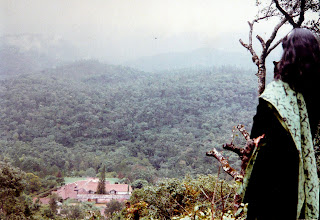Mutiny at Manipur -AD 1891-
Frank Grimwood ICS, Resident.
During the British rule of India, there have been many occasions of dissensions among the family members of the princely states. In the army too there have been many mutinies too due to various reasons. What the British used to call as “mutiny”, our historians have chosen to call as “the war of independence”. Let the wise decide the truth.
During the reign of Queen Victoria, in AD1891, the following interesting and bloody incidents happened in Manipur.
The Manipur state was a comparatively un-known member of the family of Indian sovereignties, when the tragic events of the murder of Mr. James Quinton, the Chief Commissioner of Assam, and of others of his party, brought it into an evil notoriety, and made it the platform for the public declaration of important principles on the subject of political relations.
In AD 1886, Maharaja Surchandra Singh succeeded his father Chandra Kirti Singh, to the throne in Manipur. Though Surchandra Singh was the eldest son, the royal family of Manipur got divided into two factions. On one side, the four brothers, Yuvraj Kullachandra, Tikendrajit, Angousana and Zillanamba joined hands against the king. Surchandra Singh and his three brothers rushed to Calcutta and appealed to the British government for help. While they were away, in a palace revolt, Kullachandra became the king and Tikendrajit was made the Yuvraj of Manipur. The British Government wanted to take advantage of the internal dissensions of the royal family and took some decisive steps to bring Manipur completely under its control.
Lord Lansdowne was the Viceroy of India and in February 1891, he instructed Mr. James Quinton, Chief Commissioner of Assam to interfere in the affairs of Manipur. It was decided to remove the Senapati (Commander of the Manipur Army) Tikendrajit from Manipur and to recognize Regent Kullachandra as Maharaja.
The Chief Commissioner Mr.Quinton was also asked to make a personal visit to Manipur and he proceeded in March 1891 with an escort to Manipur to carry out these orders.
Residency at Manipur in AD 1891
He had taken with him an escort of 400 Gurkhas, under Colonel Skene. There was already a guard of a hundred Gurkhas of the 42nd, under Lieutenant Simpson, stationed at Manipur as an escort for Mr. Frank Grimwood of the ICS who was the Resident of Manipur. Quinton reached Manipur early on the morning of March 22nd, and summoned a durbar for the same afternoon. The durbar met, but the Senapati, who evidently had some information of what, was intended, refused to leave the palace and meet the Commissioner. The durbar was adjourned till next day. Meanwhile, Grimwood saw the Rajah and endeavoured to impress upon him the importance of his minister attending the durbar, warning him that his absence would be a dangerous defiance of the Government's authority. But on the 23rd the Senapati was still contumacious, and it was resolved to effect his arrest by force.
Accordingly at dawn on the next day Colonel Skene, of the Gurkhas, entered the palace. But the Manipuris had prepared for resistance with the palace swarming with men (more than 6,000 it was said). As the Gurkhas entered, hundreds of rifles opened on them from roofs, windows, and loop holed walls. Lieutenant Brackenbury, who led it, was literally riddled with bullets which eventually proved mortal, and his Subedar, Heema Chund, and Havildar were killed.
The Manipur men came swarming after them, and the Residency buildings which were badly fitted for defence, were soon closely besieged. The Residency was bombarded at close range. One shell burst in the stable and killed all the horses. Colonel Skene, after a consultation with his colleagues, decided to try negotiations. Cease fire was declared and Mr. Quinton, his secretary, Mr. Cossins, the Resident, Mr. Grimwood, and Colonel Skene and Lieutenant Simpson, of the Gurkhas, came out to meet the Rajah and his chiefs.
All of them along with their bugler were beheaded by the public executioner just in front of the two dragons by the order of Yuvraj Tikendrajit Singh and General Thangal on 24th March 1891. After this, the Manipur troops attacked all the British outposts in Manipur. In the northern side, two British officers of the Telegraph Department viz. Mr. W.B. Melville, Superintendent of Telegraph and Mr. O’Brian, a signaller also lost their lives.

The dragon in front of the Residency
The British Force, now without leaders, managed to escape from the Residency with the Resident’s widow – Ethel Grimwood – who had been active throughout the siege and now helped guide them to safety. For her great gallantry Mrs. Grimwood received the insignia of the Royal Red Cross, a pension for life and was fêted by Royalty.

Ethel Grimwood
The party reached Lakhipur on 20 March and three columns under Colonel Rennick, Major-General Collett, and Brigadier-General Graham, were raised. They converged on Manipur on 26 April to find that the palace had been burnt and the Ruler, the Senapati, Tikendrajit and their brothers had fled. The ruler, his brother Prince Angousana and the Senapati, Tikendrajit were later captured and tried. The Senapati Tikendrajit Singh , General Thangal , Niranjan Subedar(who had defected from army and joined Manipur forces) , Jemadar Kajao Singh ( He speared Grimwood to death) and Chirai Naga (who beheaded Melville who was lying near a stream wounded) were publicly hanged. 22 rebels including the ex regent Kullachandra, prince Angaousana and others were exiled for life to the Andaman Islands or Radhakund in UP.
One Victoria Cross was awarded for this campaign – to Lieutenant C.J.W. Grant, Indian Staff Corps.

Campaign Medal IGS 1854 Clasp N.E.Frontier awarded to
434 SEPOY GHULAM HASAN, 33RD BENGAL INFANTRY
The explanations from the British Government for their actions seemed to be the following:
The Government of India in their Despatch, dated 5th June 1891, were specific that every succession must be recognized by the British Government, and no succession is valid until recognition has been given. As explained in the above, the strict rules of International law have no bearing upon the relations between the Government of India, as representing the Queen-Empress on the one hand, and the Native states under the suzerainty of Her Majesty on the other.
The paramount supremacy of the former presupposes and implies the subordination of the latter. In the exercise of their high prerogatives, the Government of India have, in Manipur as in other protected states, the unquestioned right to remove by administrative order any person whose presence in the state may seem objectionable. The rule was therefore laid down that "any armed and violent resistance to the arrest of such person was an act of rebellion, and can no more be justified by a plea of self-defence than could resistance to a police officer armed with a Magistrate's warrant in British India."
If the unlawful resistance led to the death of the agents of Government, then the persons who caused their death were guilty of murder. Therefore it was proclaimed at Manipur on the 13th of August 1891 : "It is hereby notified, for the information of the subjects of the Manipur state, that Takendrajit Bir Singh, alias the Yuvraj of Manipur, was in the month of June tried by special Commission, and convicted of waging war against the Queen-Empress of India, and abetment of the murder of British officers, and was sentenced to be hanged, which sentence has been confirmed by the Government of India, and will be duly carried out."
Then followed other sentences commuted to transportation for life with forfeiture of all property. The proclamation ended thus: “The subjects of the Manipur state are enjoined to take warning by the punishments inflicted on the above named persons found guilty of rebellion and murder."
Thus ended another chapter in Indian history soaked with plenty of blood and much bitterness.
Dubai, 7th February 2008.
PS: Readers who are interested can download the book "My Three Years in Manipur and Escape from the Recent Mutiny" by Ethel St. Clair Grimwood (fl.1891)London: Richard Bentley and Son, 1891. (Third Edition) from the site http://digital.library.upenn.edu/women/writers.html





Comments